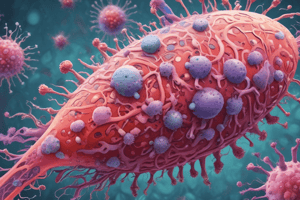Podcast
Questions and Answers
What are the common methods of transmission for varicella?
What are the common methods of transmission for varicella?
- Through contaminated food and water only
- Contact with contaminated surfaces only
- Airborne and contact (correct)
- Vector borne transmission
Which of the following is a typical symptom of varicella?
Which of the following is a typical symptom of varicella?
- Localized rash on the limbs
- Fever, malaise, and a rash that starts on the trunk and face (correct)
- High fever with no rash
- Severe abdominal pain
What type of skin lesions are associated with varicella?
What type of skin lesions are associated with varicella?
- Dry, non-itchy patches
- Subcutaneous nodules
- Maculopapular lesions that crust and are itchy (correct)
- Ulcers that do not crust
What is a potential long-term risk for individuals who have had varicella?
What is a potential long-term risk for individuals who have had varicella?
When is the recommended age for the first varicella vaccination?
When is the recommended age for the first varicella vaccination?
Flashcards
Varicella
Varicella
Commonly known as chickenpox, it spreads through the air and by contact.
Symptoms of Varicella
Symptoms of Varicella
Fever, discomfort, a rash primarily on the trunk and face, spreading elsewhere, dehydration, itchy lesions that crust over.
Progression of Varicella Lesions
Progression of Varicella Lesions
Macules -> papules -> vesicles -> scabs (with severe crusting).
Risk Following Varicella
Risk Following Varicella
Signup and view all the flashcards
Treatments for Varicella
Treatments for Varicella
Signup and view all the flashcards
Study Notes
- Varicella, commonly known as chickenpox, is transmitted through both airborne particles and direct contact.
- Symptoms include fever, malaise, and a rash that starts on the trunk and face before spreading.
- Additional symptoms involve dehydration and itchy maculopapular lesions that crust over.
- Lesions progress through stages: papule, vesicle, and scab, culminating in severe crusting.
- Individuals who have had chickenpox are at risk of developing shingles later in life.
- Vaccination involves two doses: the first at 12-15 months (not before 12 months), and the second between 4-6 years.
- A rash may occur at the injection site post-vaccination.
- Severe cases can be treated with IV acyclovir.
- Symptomatic relief includes calamine lotion for itching, oatmeal baths, and maintaining hydration.
Studying That Suits You
Use AI to generate personalized quizzes and flashcards to suit your learning preferences.
Description
Explore varicella (chickenpox): its transmission via airborne particles and direct contact. Learn about symptoms like fever, rash progression, and potential complications like shingles. Discover vaccination schedules and treatments, including acyclovir and symptomatic relief.




